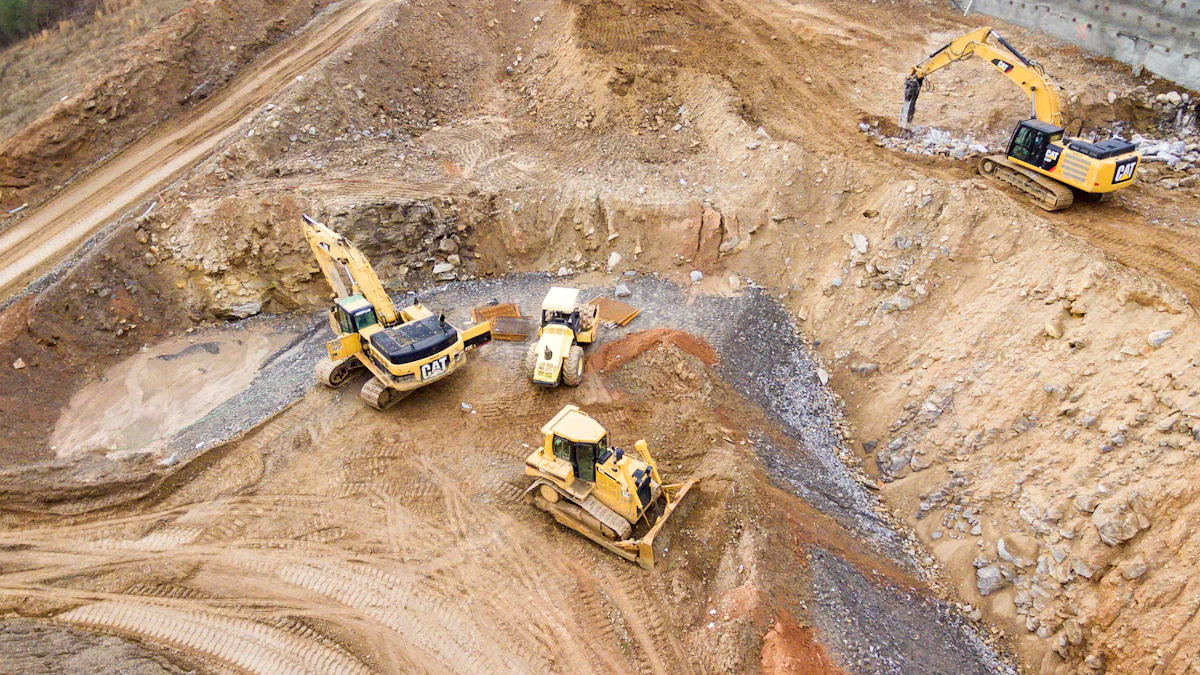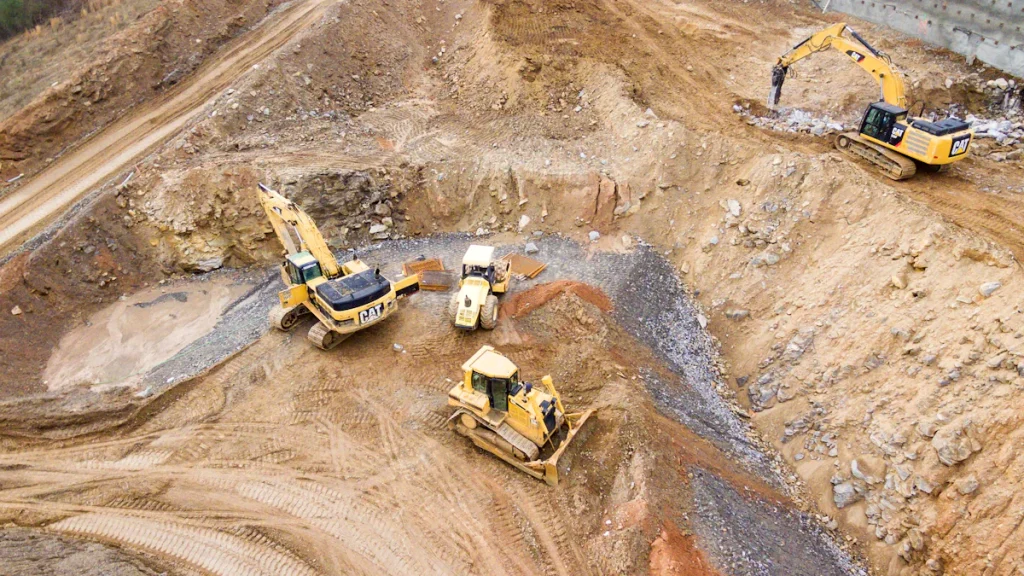
Excavators are powerful machines that rely on a variety of components to function effectively. Each part of an excavator plays a crucial role in its operation, ensuring that the machine performs efficiently and safely. By understanding these components, you can make informed decisions about maintenance and repairs, enhancing the machine’s performance and longevity. Whether you’re involved in construction or demolition projects, knowing the parts of an excavator empowers you to optimize its use and ensure its durability.
Key Takeaways
Understanding the components of an excavator, such as the undercarriage, house, and hydraulic system, is essential for effective operation and maintenance.
Regular inspection and maintenance of tracks, sprockets, and idlers in the undercarriage can significantly enhance the excavator’s mobility and longevity.
The cab of the excavator is designed for operator comfort and safety, featuring controls that allow for precise maneuvering and a 360-degree view.
Maintaining the hydraulic system, including pumps and cylinders, is crucial for ensuring the excavator operates efficiently and reliably.
Utilizing additional attachments like augers and grapples can expand your excavator’s capabilities, making it a versatile tool for various tasks.
Regularly checking and replacing worn parts not only optimizes performance but also extends the lifespan of your excavator, ensuring it remains a reliable asset on the job site.
Choosing high-quality parts from reputable suppliers, such as YNF Machinery, can enhance the performance and durability of your excavator.
The Undercarriage: Foundation of Excavator Mobility
The undercarriage forms the backbone of an excavator’s mobility. It supports the machine and allows it to move across various terrains. Understanding the components of the undercarriage is crucial for maintaining the efficiency and longevity of your excavator.
Tracks
Tracks are essential for an excavator’s movement. They are typically made from steel, rubber, or a combination of both. These materials provide durability and flexibility, allowing the excavator to traverse different surfaces with ease. Tracks distribute the machine’s weight evenly, reducing ground pressure and preventing the excavator from sinking into soft ground. Regular inspection and maintenance of the tracks ensure smooth operation and prevent premature wear.
Sprockets
Sprockets play a vital role in converting engine power into movement. They engage with the tracks, driving them forward or backward. Properly functioning sprockets ensure efficient power transmission and smooth operation. Regular checks for wear and alignment are necessary to maintain optimal performance. Replacing worn sprockets promptly can prevent further damage to the tracks and other undercarriage components.
Idlers
Idlers support and guide the tracks, maintaining tension and alignment. They help distribute the machine’s weight evenly, reducing stress on the tracks and other components. Properly adjusted idlers prevent track derailment and ensure smooth operation. Regular inspection and adjustment of idlers are essential to avoid excessive wear and prolong the life of the undercarriage.
Maintaining the undercarriage is crucial for the overall performance of your excavator. Regular inspections, adjustments, and replacements of worn parts can enhance the operational life of the machine. By understanding these parts of an excavator, you can ensure its mobility and efficiency on the job site.
The House: Core Components of an Excavator
The house of an excavator serves as the central hub, housing essential components that ensure the machine’s functionality and safety. Understanding these parts of an excavator is crucial for effective operation and maintenance.
Cab
The cab acts as the control center of the excavator. You, as the operator, sit here to manage the machine’s operations. Modern cabs offer a comfortable and safe environment, equipped with features like air conditioning, heating, and sound insulation. These features enhance your comfort and productivity. The cab also includes essential controls such as joysticks and foot pedals, allowing you to maneuver the excavator with precision. Additionally, the cab provides a 360-degree view, ensuring maximum visibility and safety. It incorporates ROPS (Rollover Protective Structure) and FOPS (Falling Object Protective Structure) to protect you from potential hazards.
Engine
The engine powers the excavator, providing the necessary force to perform various tasks. It is the heart of the machine, converting fuel into mechanical energy. Regular maintenance of the engine ensures optimal performance and longevity. You should check for any signs of wear or damage and replace parts as needed to prevent breakdowns.
YNF Machinery’s Excavator Engine Parts
YNF Machinery offers high-quality excavator engine parts designed for durability and efficiency. These parts include pistons, cylinders, and crankshafts, all crafted to withstand harsh conditions. By choosing YNF Machinery’s products, you ensure reliable performance and reduced downtime. Their parts meet or exceed OEM standards, providing you with peace of mind and cost-effectiveness.
Counterweight
The counterweight balances the excavator, preventing it from tipping over during operation. It is a crucial component that ensures stability, especially when lifting heavy loads. You should regularly inspect the counterweight for any signs of damage or wear. Proper maintenance of the counterweight enhances the safety and efficiency of your excavator.
Understanding the house components of an excavator empowers you to operate the machine safely and efficiently. Regular maintenance and inspection of these parts ensure the longevity and reliability of your excavator.
The Boom, Stick, and Bucket: Essential Digging Tools

Excavators rely on three primary components for their digging capabilities: the boom, stick, and bucket. These parts of an excavator work together to perform various tasks, from digging trenches to lifting heavy materials.
Boom
The boom serves as the upper arm of the excavator, extending outward from the machine’s main body. It plays a crucial role in lifting and moving heavy objects. You control the boom using hydraulic cylinders, which provide the necessary power and precision for various tasks. The boom connects directly to the house of the excavator, forming the backbone of the machine’s arm. Regular maintenance of the boom ensures its durability and efficiency, allowing you to perform tasks with ease and accuracy.
Stick
The stick, also known as the dipper arm, attaches to the boom and extends the reach of the excavator. It acts as an intermediary, transferring power from the boom to the bucket. The stick’s design allows for forward and backward movements, increasing the machine’s operating radius. This flexibility enables you to position the bucket accurately for excavation. By maintaining the stick in good condition, you ensure smooth operation and precise control over digging depth and reach.
Bucket
The bucket is the most recognizable part of an excavator, performing the actual digging and material handling tasks. It attaches to the end of the stick and comes in various shapes and sizes, depending on the specific job requirements. Buckets can dig, scoop, and transport materials, making them versatile tools on any construction site. Regular inspection and replacement of worn teeth or edges on the bucket enhance its performance and longevity.
Understanding these essential digging tools empowers you to operate the excavator efficiently and safely. By maintaining each component, you ensure the machine’s optimal performance and extend its lifespan.
Hydraulic System: Powering Excavator Operations
The hydraulic system is the powerhouse of an excavator, enabling it to perform a wide range of tasks with precision and efficiency. Understanding the components of this system is crucial for maintaining the machine’s performance and reliability.
Hydraulic Pumps
Hydraulic pumps are essential for providing high-pressure oil to various parts of an excavator. They convert mechanical energy into hydraulic energy, powering the hydraulic cylinders and other actuators. You rely on these pumps to ensure smooth and efficient operations. Regular maintenance of hydraulic pumps is vital to prevent fluid leaks and optimize fuel consumption. By keeping the pumps in good condition, you enhance the productivity and reliability of your excavator.
Hydraulic Cylinders
Hydraulic cylinders play a crucial role in an excavator’s movements. They enable the boom, lift arm, and bucket operations, contributing to the machine’s overall performance and efficiency. You depend on these cylinders to perform tasks with precision and power. Regular inspection and maintenance of hydraulic cylinders ensure their longevity and effectiveness.
YNF Machinery’s Hydraulic Cylinder Seal Kits
YNF Machinery offers high-quality hydraulic cylinder seal kits designed to prevent oil leaks and ensure smooth operation. These kits are crafted from high-grade materials, providing durability and flexibility. By choosing YNF Machinery’s seal kits, you solve oil leakage problems effectively, enhancing the efficiency and lifespan of your excavator. Their products meet international quality standards, making them a reliable choice for excavator maintenance.
Hydraulic Fluid
Hydraulic fluid is the lifeblood of the hydraulic system. It transmits power, lubricates components, and reduces wear and tear. You must regularly check the hydraulic fluid levels and quality to ensure optimal performance. Using the right type of hydraulic fluid is crucial for preventing system failures and maintaining the efficiency of your excavator.
Understanding the hydraulic system empowers you to maintain your excavator’s performance and reliability. Regular maintenance and inspection of these parts of an excavator ensure its longevity and efficiency on the job site.
Control System: Operator’s Interface
The control system in an excavator serves as the operator’s interface, allowing you to manage the machine’s functions with precision and ease. Understanding this system is crucial for efficient operation and safety.
Operator Controls
You will find the operator controls within the cab, which acts as the command center of the excavator. These controls include joysticks, foot pedals, and various switches that allow you to maneuver the machine. Joysticks control the boom, stick, and bucket movements, while foot pedals manage the tracks’ forward and backward motion. The layout of these controls is designed for intuitive use, enabling you to operate the excavator smoothly and efficiently.
Modern excavators often feature advanced control systems that enhance your ability to perform tasks with precision. These systems may include digital displays that provide real-time information about the machine’s status, such as fuel levels and engine performance. By familiarizing yourself with these controls, you can optimize the excavator’s performance and ensure safe operation.
Electronic Systems
The electronic systems in an excavator play a vital role in its functionality. These systems include sensors, monitors, and diagnostic tools that help you maintain the machine’s efficiency. Sensors provide feedback on various parameters, such as hydraulic pressure and engine temperature, allowing you to make informed decisions about maintenance and repairs.
Monitors display critical information, ensuring you are aware of the machine’s condition at all times. Diagnostic tools help identify potential issues before they become significant problems, reducing downtime and repair costs. By understanding and utilizing these electronic systems, you can enhance the excavator’s reliability and longevity.
Incorporating both operator controls and electronic systems, the control system of an excavator empowers you to manage the machine effectively. Regular maintenance and familiarity with these components ensure optimal performance and safety on the job site.
Additional Attachments: Enhancing Excavator Versatility

Excavators can transform into multi-purpose machines with the right attachments. These tools expand the capabilities of your excavator, allowing it to perform a variety of tasks beyond digging. By understanding these attachments, you can enhance the versatility and efficiency of your equipment.
Augers
Augers are essential for drilling holes in the ground. You can use them for tasks like planting trees, installing fence posts, or setting up foundations. Augers come in various sizes and designs to suit different soil types and project requirements. They provide additional reach and accessibility, making them ideal for hard-to-reach places. Regular maintenance of augers ensures their longevity and performance, allowing you to complete projects efficiently.
Grapples
Grapples are versatile attachments used for handling materials like logs, rocks, and debris. You can use them in construction, demolition, and forestry work. Grapples come in different styles, such as rotating or fixed, to meet specific job needs. They enhance your ability to lift and move heavy objects with precision. By choosing the right grapple for your project, you can improve productivity and safety on the job site.
Hammers
Hammers, also known as breakers, are powerful tools for breaking concrete, rocks, and other hard materials. You can use them in demolition projects or for road construction. Hammers deliver high-impact force, making them effective for tough jobs. Regular inspection and maintenance of hammers ensure their reliability and efficiency, reducing downtime and repair costs.
YNF Machinery’s Excavator Couplings
YNF Machinery offers high-quality excavator couplings that enhance the performance of your attachments. These couplings ensure efficient power transmission between the excavator’s engine and hydraulic pump system. Crafted from durable materials, they withstand tough working conditions, minimizing downtime and maximizing productivity. By choosing YNF Machinery’s couplings, you ensure smooth operation and reliable performance of your excavator attachments.
By incorporating these additional attachments, you can transform your excavator into a versatile machine capable of handling a wide range of tasks. Understanding and maintaining these tools enhance your equipment’s efficiency and extend its lifespan, ensuring successful project completion.
Each part of an excavator plays a crucial role in its operation. These components work together to allow the machine to perform a variety of tasks efficiently. By understanding the parts of an excavator, you can enhance safety and efficiency in excavation work. Regular maintenance and timely replacement of worn parts ensure that your excavator functions at its utmost potential. This proactive approach not only extends the lifespan of the machine but also optimizes its performance across different industrial applications. Prioritizing these practices guarantees that your excavator remains a reliable asset on any job site.
FAQ
What are some signs that my excavator parts need replacement?
You should watch for several indicators that suggest your excavator parts require replacement. These include unusual noises during operation, decreased performance, visible wear or damage, and increased fuel consumption. Regular inspections help you identify these signs early, allowing for timely maintenance and preventing further damage.
What are the common parts of an excavator?
An excavator consists of several key components that work together to perform its functions efficiently. These include the undercarriage, house, boom, stick, bucket, hydraulic system, and control system. Each part plays a vital role in the machine’s operation, ensuring it performs tasks effectively and safely.
Why is using Volvo excavator parts important?
Using Volvo excavator parts ensures compatibility and reliability. These parts are specifically designed for Volvo machines, maintaining the integrity and performance of your excavator. By using genuine parts, you keep your equipment running efficiently and reduce the risk of unexpected breakdowns.
What are the key excavator components for optimal performance?
For optimal performance, focus on maintaining the excavator’s engine, hydraulic system, and control system. These components provide the necessary power and precision for various tasks. Regular maintenance and using high-quality parts ensure your excavator operates at its best, enhancing productivity and efficiency.
What is the significance of excavator parts in heavy equipment performance?
Excavator parts are crucial for the success of construction, excavation, and mining operations. They determine the machine’s efficiency and reliability. By prioritizing the maintenance and upkeep of these parts, you ensure your equipment meets the demands of modern construction challenges, achieving both efficiency and sustainability.
How do I maintain the hydraulic system of my excavator?
To maintain the hydraulic system, regularly check the hydraulic fluid levels and quality. Inspect hydraulic pumps and cylinders for leaks or damage. Use high-quality hydraulic fluid and replace it as needed. Regular maintenance prevents system failures and ensures your excavator operates smoothly.
What role does the control system play in an excavator?
The control system serves as the operator’s interface, allowing you to manage the machine’s functions with precision. It includes joysticks, foot pedals, and electronic systems that provide real-time information about the excavator’s status. Understanding and maintaining this system ensures safe and efficient operation.
How can additional attachments enhance my excavator’s versatility?
Additional attachments, such as augers, grapples, and hammers, expand your excavator’s capabilities. They allow you to perform a variety of tasks beyond digging, such as drilling, material handling, and demolition. By choosing the right attachments, you enhance your equipment’s versatility and efficiency on the job site.
What are the benefits of using YNF Machinery’s excavator parts?
YNF Machinery offers high-quality excavator parts that ensure durability and efficiency. Their products meet or exceed OEM standards, providing reliable performance and reducing downtime. By choosing YNF Machinery’s parts, you benefit from cost-effectiveness and peace of mind, knowing your equipment is in good hands.





